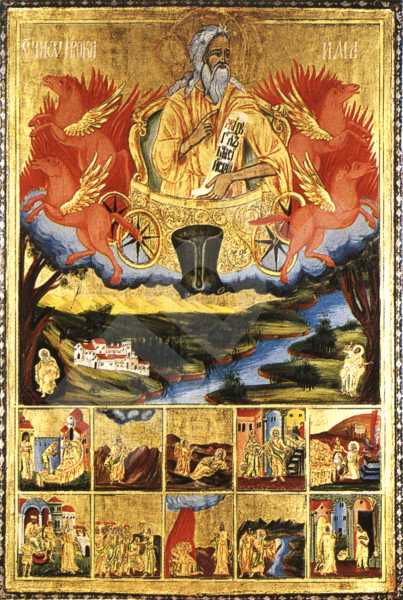Saint Prophet Elijah with scenes from his life
Type:
Icon
Period:
The middle of the
19 century
Dimmensions (cm):
126
/ 88
/ 3
Location
Country: Bulgaria
Province: Blagoevgrad
Town: Blagoevgrad
Church: The Virgin
Source
Country: Bulgaria
Province: Blagoevgrad
Town: Blagoevgrad
Church: The Virgin
Description
Portrayed to the waist in the upper half of the pictorial field is Saint Elijah, seated in a chariot. In his left hand he is holding a roll. With his bent to his chest right hand he is pointing rightwards. His head is painted in three-quarters face, with his eyes looking leftwards. The chariot is drawn by two pairs of rose-and-red winged horses. Painted in the icon's middle part is a landscape, showing the brook Khorath, a tributary of the river Jordan, and mountain ridges. On the left-hand side are the figure of Saint Elijah, secluded in the cave, and temple buildings, resembling the contours of a big monastery. Portrayed on the right-hand side is Elisha, watching the ascen¬sion of the Old-Testament prophet. Painted in the lowermost quarter of the pictorial field are scenes from the life of St. Elijah.
Iconographical technique: Tempera
The painting of the figures is done mostly on a gilding with gold-leaf and by means of velaturas. The carnations (faces, hands and feet) of the figures are painted with greenish basic tones, overlaid with ochre and ochre-and-pink brightenings.
Base material: Wood
The icon's base is made of three beechen panels, joined together by a "tooth and groove" joint and reinforced additionally with two inserted beams. The ground coat is of plaster about 1 mm thick.
State, restoration traces and comments
The icon had been restored. It is cleansed from the varnish and from the surface soilures. There are on its surface a number of pastings and retouchings, some of which have grown dark in the course of time. There are a number of well-retouched areas: around the aureole of St. Elijah, in the icon's upper left corner, the front horse's left leg on the saint's right-hand side, on the saint's hands, and elsewhere.


